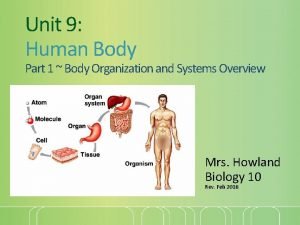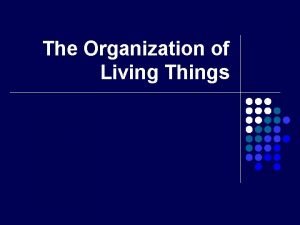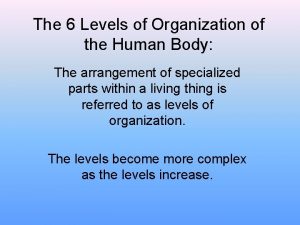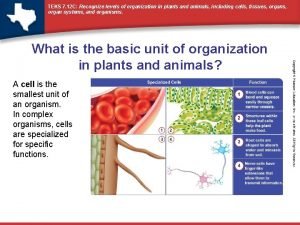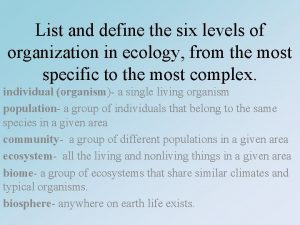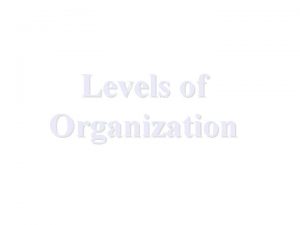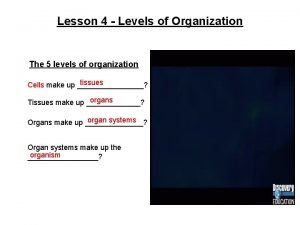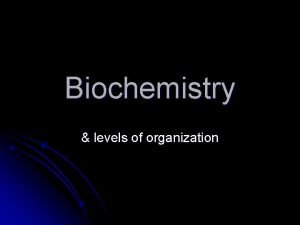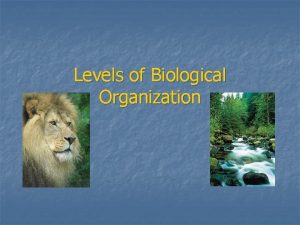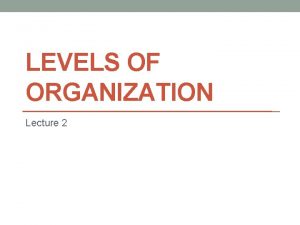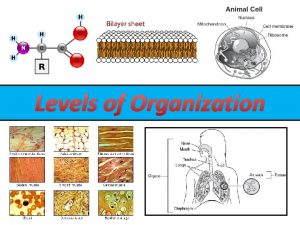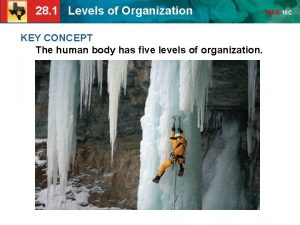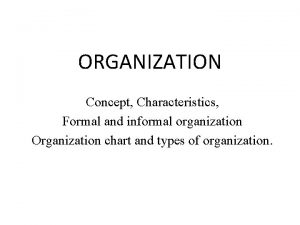28 1 Levels of Organization KEY CONCEPT The
















- Slides: 16

28. 1 Levels of Organization KEY CONCEPT The human body has five levels of organization.

28. 1 Levels of Organization Specialized cells develop from a single zygote. • Organisms are made up of specialized cells. red blood cell nerve cell

28. 1 Levels of Organization • Zygotes first divide into embryonic stem cells. • Stem cells develop in two stages. – determination, or committing to become one cell type – differentiation, or acquiring specialized structures and functions

28. 1 Levels of Organization Specialized cells function together in tissues, organ systems, and the whole organism. • Specialized cells perform specific tasks. • Tissues are groups of similar cells working together. – epithelial tissue – connective tissue – muscle tissue – nervous tissue cell tissue

28. 1 Levels of Organization • Organs are different tissues working together. • Organ systems are two or more organs working together. • Organism is all organ systems working together. ORGANS ORGAN SYSTEM ORGANISM

28. 1 Levels of Organization • Those that were not here DRAW THIS!!! Figure 28

28. 1 Levels of Organization KEY CONCEPT 28. 2 Homeostasis is the regulation and maintenance of the internal environment.

28. 1 Levels of Organization Conditions within the body must remain within a narrow range. • Homeostasis involves keeping the internal environment within set ranges.

28. 1 Levels of Organization • Control systems help maintain homeostasis. – sensors gather data pore – control center receives sweat data, sends messages glands – communication system delivers messages to target hair organs, tissues follicle – targets respond to change muscle goose bump

28. 1 Levels of Organization Negative feedback loops are necessary for homeostasis. • Feedback compares current conditions to set ranges. • Negative feedback counteracts change. Negative Feedback Loop Holding breath, CO 2 levels rise, O 2 / CO 2 level returns to normal Control system forces exhale, inhale

28. 1 Levels of Organization • Positive feedback increases change. – Torn vessel stimulates release of clotting factors platelets blood vessel fibrin clot white blood cell red blood cell – growth hormones stimulate cell division

28. 1 Levels of Organization KEY CONCEPT 28. 3 Systems interact to maintain homeostasis.

28. 1 Levels of Organization Each organ system affects other organ systems. • An organ system must do a specific job. • Organ systems must also work together to keep the organism healthy.

28. 1 Levels of Organization • Organ systems must also work together to keep the organism healthy. – Organ systems work together to produce Vitamin D. – Thermoregulation maintains a steady body temperature. UV light 1 Skin absorbs UV light 2 Liver produces inactive vitamin D 3 Kidneys produce active vitamin D 4 Active vitamin D used in bones

28. 1 Levels of Organization A disruption of homeostasis can be harmful. • Homeostasis can be disrupted for several reasons. – sensors fail – targets do not receive messages – injury – illness

28. 1 Levels of Organization • Short-term disruption usually causes little or no harm. • Long-term disruptions can cause more damage. • Diabetes is a serious long-term disruption of homeostasis. pancreas 1 Pancreas cells attacked; insulin declines 2 Blood glucose levels rise, 3 fats kidneys Body burns fat; blood more acidic, 4 Cells impaired; all organs damaged.
 Chapter 4 lesson 4 metamorphic rocks answer key
Chapter 4 lesson 4 metamorphic rocks answer key Key concept builder lesson 1 what are waves answer key
Key concept builder lesson 1 what are waves answer key Level 2 costa questions examples
Level 2 costa questions examples Unit 9 human body systems review
Unit 9 human body systems review Levels of organization atom
Levels of organization atom 6 levels of organization
6 levels of organization Plant organization levels
Plant organization levels Levels of biological systems
Levels of biological systems Levels of organization from smallest to largest
Levels of organization from smallest to largest In what way are herbivores and carnivores alike
In what way are herbivores and carnivores alike Smallest part of the plant
Smallest part of the plant Levels of organization in an ecosystem
Levels of organization in an ecosystem Chapter 3 lesson 1 introduction to global systems
Chapter 3 lesson 1 introduction to global systems 5 levels of organization
5 levels of organization Levels of biological organization from smallest to largest
Levels of biological organization from smallest to largest 5 levels of organisms
5 levels of organisms Levels of organization in ecosystem
Levels of organization in ecosystem



